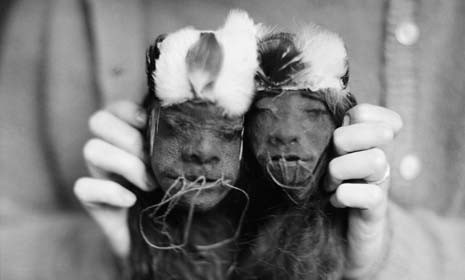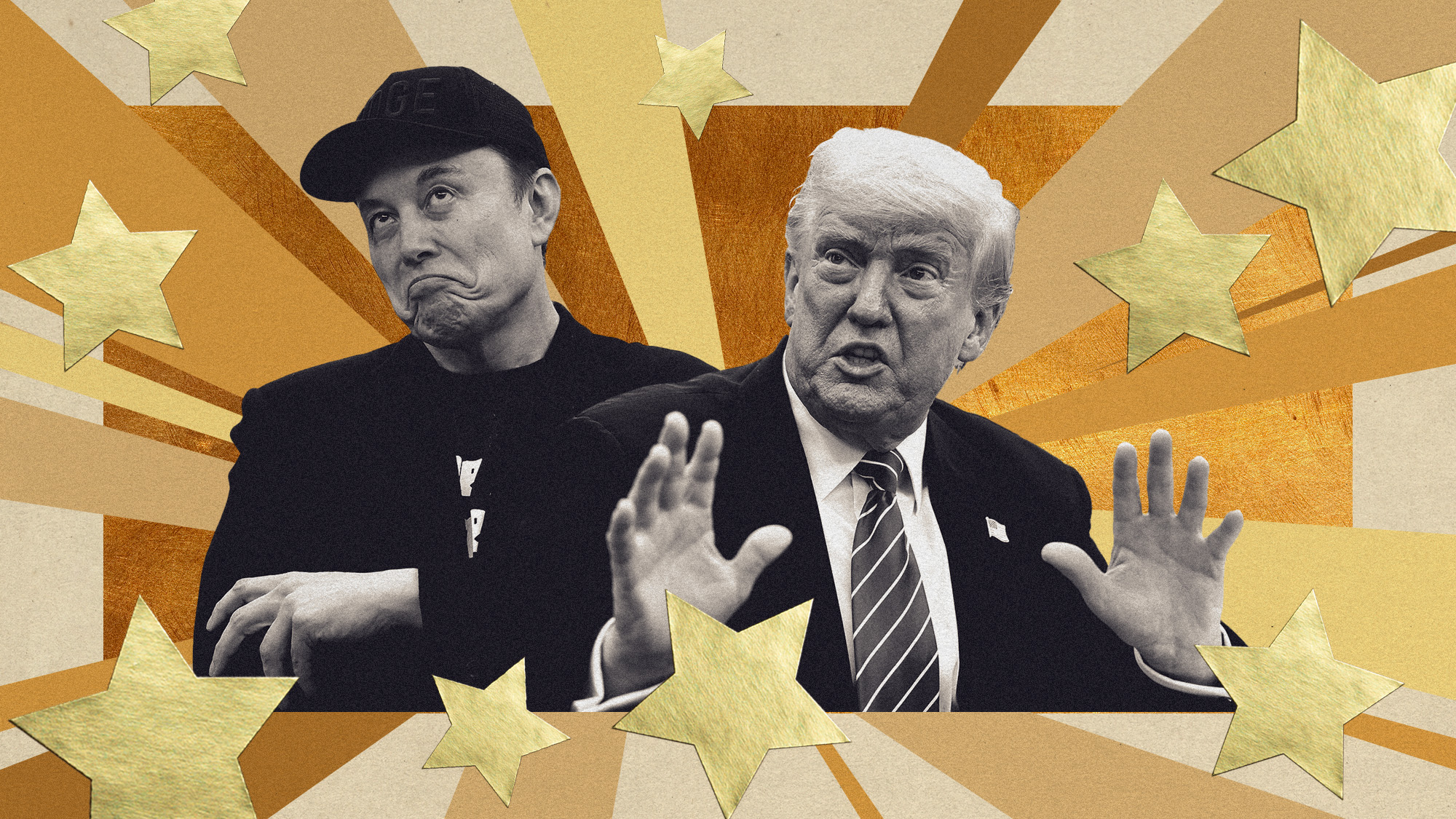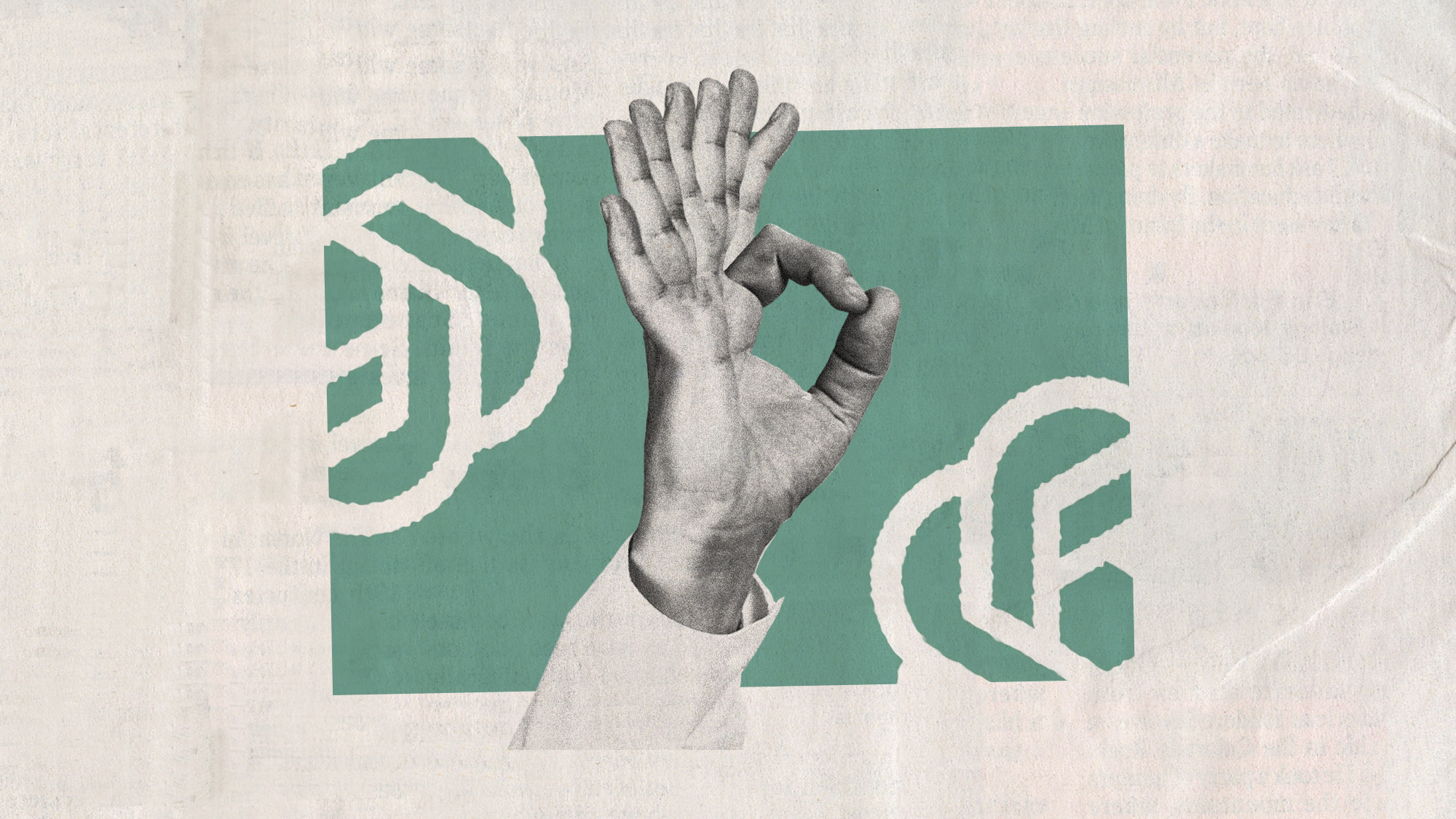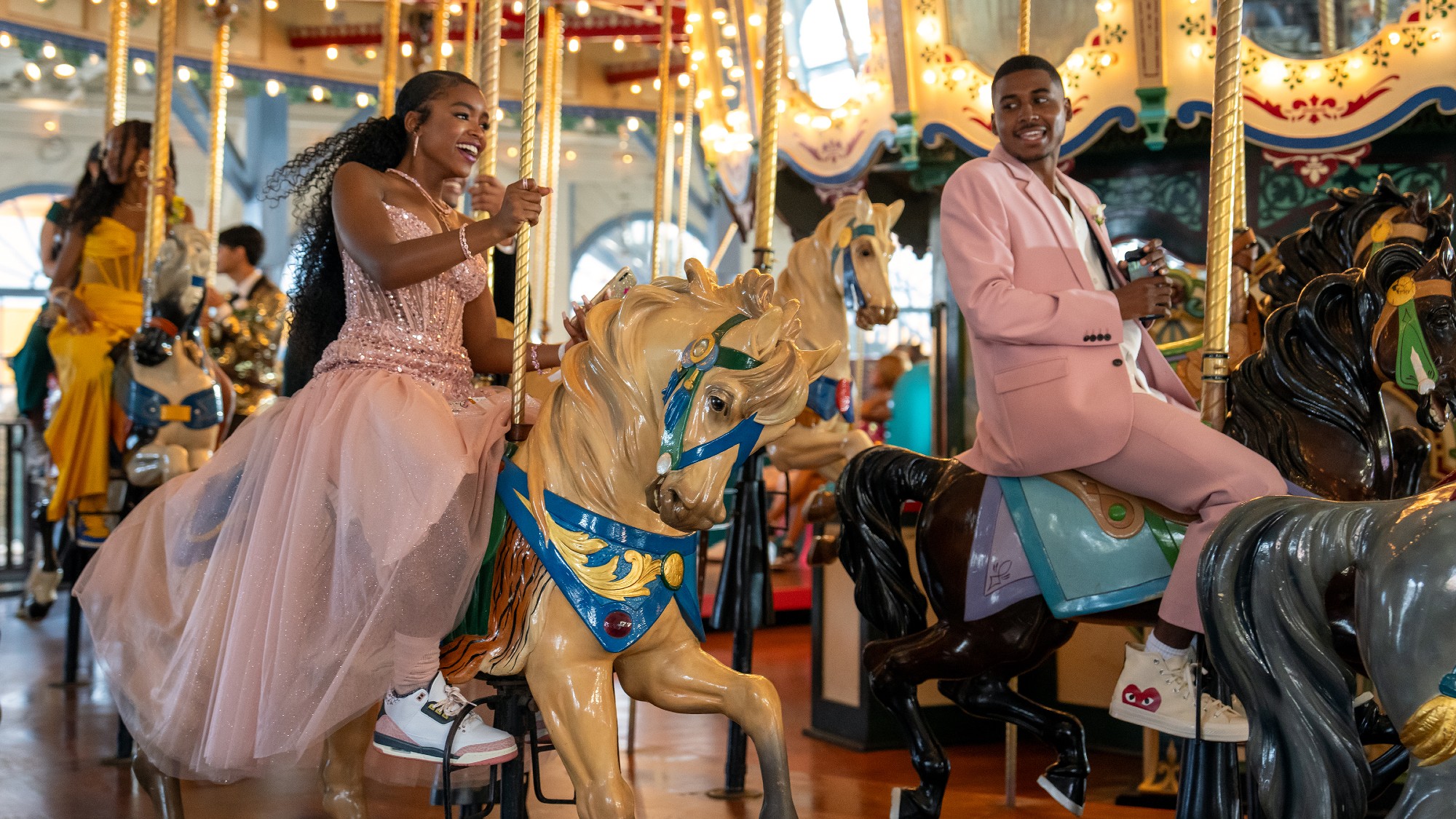The Amazon's head hunters and body shrinkers
I've seen a few shrunken heads in my time, says author Mary Roach, but a 'shrunken boy' seemed like a myth

MY FOUR YEARS With the Head Hunters of the Amazon," announces the cover of a circa-1940 brochure detailing a lecture that a man named Gustav Struve would give, for a fee, at your local Shriners club or ladies auxiliary. The pamphlet describes him as the sole survivor of an "ill-fated botanical expedition." Struve, it says, was taken captive by head hunters, married the chief's daughter, and learned "the secret process of shrinking human heads and even entire bodies."
Shrunken bodies? Struve appeared to have proof; a photo showed a shrunken man nestled in his palm like a passenger in a bucket seat.
Having learned about two shrunken men on display at New York City's Museum of the American Indian, natural-history writer Caroline Alexander set out to determine their origins in 1993. Museum records provided little beyond this: A doctor from Ecuador, Gustav Struve, had sold them to the museum in the early 1920s. Alexander located Struve's son, now deceased but then living in Quito, who told her interpreter, "Papa used to make the mummies."
The Week
Escape your echo chamber. Get the facts behind the news, plus analysis from multiple perspectives.

Sign up for The Week's Free Newsletters
From our morning news briefing to a weekly Good News Newsletter, get the best of The Week delivered directly to your inbox.
From our morning news briefing to a weekly Good News Newsletter, get the best of The Week delivered directly to your inbox.
One person who saw Alexander's story in Outside was Struve's grandnephew David Brown, who works at a natural-foods co-op in Boise, Idaho. During an expedition to his parents' Idaho basement in 2003, Brown stumbled upon a box of the old man's papers and decided to write a book about him. So a few months ago, Brown was headed to the Chicago-based Adventurers Club to examine a "shrunken boy" that Gustav had donated in 1935. This one was a new specimen, distinct from Alexander's mystery men and the one pictured in Struve's lecture brochure. And, best of all, it could be viewed in person. Both Alexander and Brown had been denied permission to look at the museum's bodies, which had been removed from public display in the late '70s.
It was a rare opportunity to examine a shrunken body and what would appear to be the uniquely twisted mind of Gustav Struve.
THERE'S A REASON hunters' trophies tend to end at the neck. A head is more practical than a body. It's easier to transport, it's less time-consuming to prepare, and it confers the same bragging rights. Today, I count 29 heads — most taxidermied, some shrunken — on display in the Adventurers Club's spacious old headquarters in downtown Chicago. Plus four attached to torsos: mine, David Brown's, club honcho Howard Rosen's, and that of Struve's shrunken boy.
We're having lunch around the club's Long Table. The walls and ceiling beams are hung with fringed expedition flags commemorating the adventures that are the primary requirement for membership here. Brown is here to do research. He has taken two years off from his job to devote himself to "Investigating the Life of Dr. Gustavo Struve" (as stated on his current business card). He is 57 but looks younger, the gray in his beard just starting to get the upper hand on the red.
A free daily email with the biggest news stories of the day – and the best features from TheWeek.com
Like a cop or an undertaker, Brown has grown blasé about the grisly particulars of his current work. He refers to head shrinking as a "kind of craft." As in, "It wouldn't bother me to have my head shrunk. If I found someone who did this kind of craft."
"Teach me!" Rosen says in his gleeful, booming bass. "If you go before me, I'll do you!"
Lunch plates are cleared. A staffer has unlocked a glass-fronted display cabinet and is wordlessly removing bell jars that hold the club's collection of shrunken heads, placing them in front of Brown and me. It's like some cheesy horror movie where the guest is treated with the utmost decorum until he lifts a plate cover and finds he's been served the head of his beloved.
"Here comes the boy," Brown says.
Thirteen inches from heel to crown, the specimen is mounted on a mahogany stand that could serve as a paper-towel holder. The first thing you notice is the skin color. The Shuar, an Amazonian tribe known for shrinking the heads of slain enemies, believed that killing a man created an avenging soul that would leave the corpse via the mouth and come after the perpetrator. Lips were sewn shut to prevent this, and true ceremonial tsantsas [a Shuar word for shrunken head] have blackened skin, the result of the killer having rubbed it with charcoal to prevent the victim's spirit from "seeing" out.
"Gustav told us it had been given to him by the Shuar and that he carried it out when he escaped," Brown says. "He never told us that he himself shrunk humans."
Brown has his laptop open and has been clicking through images from his family's photo albums. He shows me a 1955 shot of Struve and his wife, Gertrude, seated at a restaurant table for a family dinner in Los Angeles. Bowls and spoons are set before them. Struve looks at the camera with the mild peevishness of an old guy who wants to have his soup. He wears dress suspenders over a short-sleeved button-down shirt and sports the pencil-thin mustache he wore most of his adult life. I remark to Brown that it's hard to picture this natty gentleman flaying bodies and boiling skins.
"Check the pattern on the shirt," he says. I lean in closer. The shirt is decorated with a row of tsantsas, life-size and garish, with lips sewn shut and flowing Wonder Woman hair.
Brown seems a little conflicted. On one hand, he hopes to launch a writing career by conveying the lurid escapades of his granduncle. On the other, he seems protective of a beloved family member's reputation. "He was a warm guy, loved kids." The most memorable of Gustav's stories, of course, involved jungle savages who shrank their enemies' heads and bodies.
It's the bodies that, for me, raise a red flag. None of the Jívaro — a Spanish term for the Shuar and Achuar tribes — ethnographies mention a tradition of shrinking anything below the neck. Members of a Shuar war party would strike and retreat swiftly, sticking around just long enough to hack the heads off the fallen and string them on strips of bark or tie them to their headbands. Then they'd flee the scene, heads bobbing against their backsides. To drag off a whole body — even a boy's — would slow a warrior down and put him at risk of retaliation.
So where did this ghastly object come from? Did Struve make it, as Caroline Alexander suspected? Why? Who shrinks a child?
GUSTAV STRUVE WAS born in Ecuador in 1893 to parents of German descent. He earned a surgical diploma from a university in Guayaquil in 1918, a year after marrying an Ecuadoran woman, with whom he had one son. His résumé lists a span of six years spent traveling around South and Central America in an unspecified "commercial capacity." He settled for periods in Lima, Peru; Panama; and the Amazon, and his prolonged absences from his wife devolved into a permanent separation. He traveled to the United States in 1925, settling in Chicago, where he worked for the Argentine consulate. In 1939, he married Gertrude.
Whether or not Struve made all the specimens himself, he was clearly, as Brown puts it, "a purveyor." Brown shows me a letter from June 1937, a reply from the director of the Fleishhacker Zoo, in San Francisco, whom Struve had contacted for advice on where to sell "Jívaro shrunken head trophies." Struve sold one to the Adventurers Club in 1933 for $52.50 — about $860 in today's dollars. And one of the two shrunken men purchased by the American Indian museum fetched $500, a big sum in 1923. Struve's grandson told Brown that he recalled his grandmother talking about her husband's trips into Jívaro country to provide medical care.
Brown, handling the shrunken boy in Chicago, turns the body over to inspect the seams on its back. They look glued with some sort of crude sealant, not sewn. So it appears that there were at least two body shrinkers at work.
Likely far more. A spin through the various Jívaro ethnographies reveals that counterfeit human shrinking was a thriving cottage industry. "The majority of heads which leave the country...were never in the hands of the Jívaro but were prepared by various individuals from the bodies of unclaimed paupers to supply the constant demand of tourists and travelers," ethnographer M.W. Stirling wrote in a 1938 volume of the bulletin of the Bureau of American Ethnology.
M.W. Stirling contended that counterfeit tsantsas were made at various places in Ecuador, Colombia, and Panama as far back as 1872, when "a white man living on the borders of the Jívaro country" apparently learned the craft from the natives. The time frame — late 1800s to early 1900s — corresponds with the equally gruesome and lucrative trade in freshly buried corpses dug up by body snatchers and sold to anatomy schools in England and the U.S.
If you know what to look for, it's usually a simple matter to detect a counterfeit tsantsa. The fakes often have facial hair; the Shuar took care to singe it off. The lips of counterfeit tsantsas are closed with unwoven strips of vine rather than string, and they lack the holes in the head that would enable a warrior to hang them around his neck during ceremonies.
Here's what surprised me most: The Shuar themselves were prolific commercial head shrinkers. Beginning in the mid-1940s, word spread throughout the region that a tsantsa could be traded for a shotgun. Around the same time, anthropologist John Patton told me, the Shuar gained a tactical advantage over their Achuar enemies. The Achuar had long controlled the rivers, affording access to trade routes and opportunities to barter for superior firearms being made in Brazil and traded up through Peru and Ecuador. Because Shuar head hunters faced retaliation from the better-armed Achuar, head-taking raids were sporadic and carefully considered. And then the balance shifted. A critical section of border closed, cutting off the Achuar's access to trade and ammunition. The Shuar got busy.
"A hundred and fifty Shuar warriors would go and take heads, whole families," says Patton, "partly because they had a commercial outlet for it and also because when the Achuar were reduced to using spears it was a lot easier to do." Patton told me that the Shuar, around that time, would refer to the Achuar as fish — as in, "Let's go catch some fish."
Inside the Adventurers Club, Brown closes his laptop. The boy is returned to his place in the display cabinet, near a General Tojo suicide photo and a deck of cards that Roald Amundsen carried to both poles.
"All these guys traveling around with suitcases full of shrunken heads and bodies, filling the public's collective mind with images of crazed savages," Brown says, summing up. "Meanwhile, the folks down south are cranking out heads, picking up the slack when the Jívaro failed to keep up with the demand. And the 'professionals' at museums would put them on display as genuine artifacts and enjoy the extra sales at the ticket booth. What a trip."
©2011 by Outside, adapted from a longer article. Reprinted by permission of the publisher and the author.
-
 Biggest political break-ups and make-ups of 2025
Biggest political break-ups and make-ups of 2025The Explainer From Trump and Musk to the UK and the EU, Christmas wouldn’t be Christmas without a round-up of the year’s relationship drama
-
 Why 2025 was a pivotal year for AI
Why 2025 was a pivotal year for AITalking Point The ‘hype’ and ‘hopes’ around artificial intelligence are ‘like nothing the world has seen before’
-
 The best drama TV series of 2025
The best drama TV series of 2025the week recommends From the horrors of death to the hive-mind apocalypse, TV is far from out of great ideas